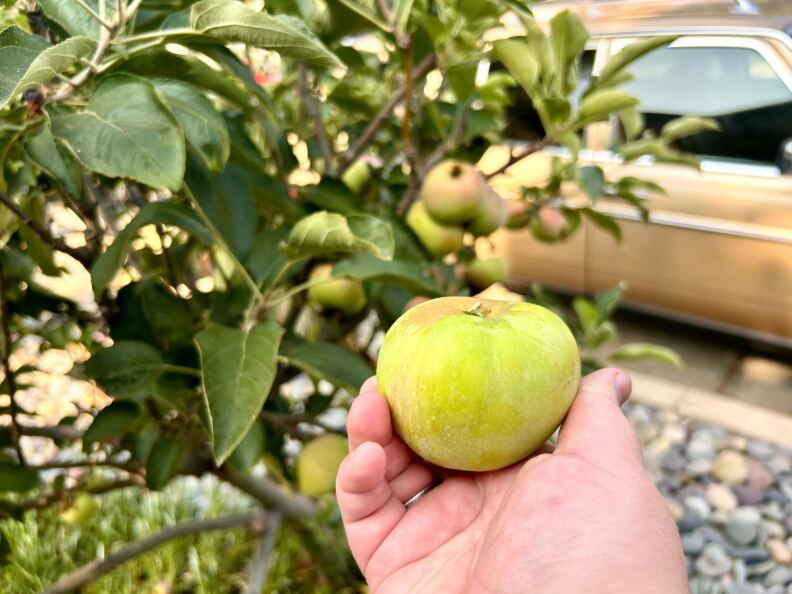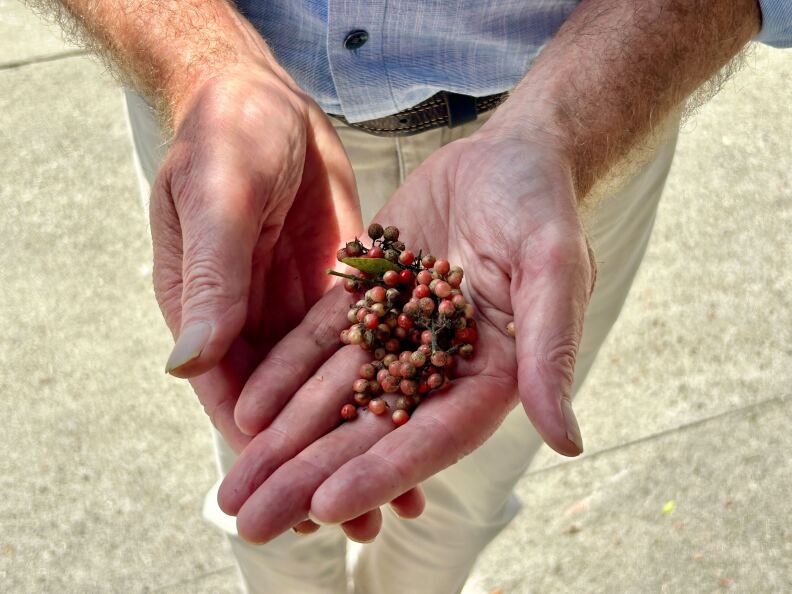Have you ever noticed fruit growing around your neighborhood?
No, not your neighbor’s oranges — there are fruit trees spread across Los Angeles County that anyone can take from. These trees are important because for every piece of food we eat that comes from a faraway farm, it creates planet-heating pollution.
Could eating what’s growing on L.A. streets help reduce our carbon impact?
Gleaning in my neighborhood
I was on a mission to find out. So, I went on my phone to a map from Falling Fruit. The map is where anyone can place pins of fruit trees they see — like figs, lemons and even grapes — and go out to pick them. This kind of gathering is called gleaning, which is when excess food in public areas gets harvested.
I looked up potential pickings near me in the San Fernando Valley, and stop one was within minutes from me.
I quickly found a tall tree full of grapefruit in front of an apartment complex, right near a busy street. It had so much fruit that there were even some on the ground. I reached out to try one, but they were small and green — a telltale sign they weren’t ripe enough. So, I moved on.
While I eventually found figs, citrus, and apples within the hour, there were some issues.
Sometimes, the trees were on private property with branches that overhang public areas. City laws are a bit ambiguous on whether it’s legal to pick fruit hanging that way, so it’s best to pick from spots that are clearly in the public right of way. Other times, fruits weren’t ripe enough or the map was outdated.
I lucked out! The most gleaning fruits were near our LAist office in Pasadena. A few small apple trees were just blocks away, and although they also weren’t ripe yet (curses!), it was promisingly along the public right of way.

With how much fruit I found, it made me wonder if I could feed myself regularly like this instead of buying them from a supermarket. Grocery stores are filled with foods that are produced in ways that contribute to global heating. Things like poor soil management and methane emitted from livestock means large scale food production spews about a quarter of the world’s human-caused greenhouse gas emissions.
The public food effort
I met up with Douglas Kent at Del Aire Park in Hawthorne to learn more. He teaches students about ecological land management at USC’s School of Architecture and at Cal Poly Pomona’s John Lyle Center for Regenerative Studies — he’s also an expert forager for finding food in Southern California cities.
“I really like public parks,” Kent said about his favorite foraging spot. “Any public park, it doesn’t make a difference. The more people, the more weeds there are going to be, and the more spontaneous vegetation I’m going to get.”

But Del Aire Park does have a special quality — we can forage herbs here and glean fruits. Right near the entrance, the group Fallen Fruit planted 27 fruit trees in 2013, including eight native grape vines, as a public art project aimed at building community through urban orchard care.
On our visit, county grounds worker Bryan Spragg said multiple trees have died because people stopped coming to care for them. For the ones alive, the fruit was mostly picked over.
“A lot of the time, kids come and pick them off before they even get a chance,” Spragg said.
Could it work with more fruit trees? While some places are trying, Aaron Fox, an urban and community agriculture professor at Cal Poly Pomona said cities don’t like planting fruit trees.
-
- Food Forward is a nonprofit organization that plans gleanings from fruit trees, farmers markets, farmers, and wholesale markets for distribution to local hunger relief organizations.
- The L.A. Food Bank also allows gleaning volunteers.
“They’re worried they’ll attract pests and fruit trees are more challenging to maintain,” Fox said. “A well organized and dedicated gleaning program could help assuage these concerns, but that typically requires funding.”
L.A. has gleaning groups. A 2015 city ordinance also allows Angelenos to plant fruits and vegetables in the strip of land between the sidewalk and the street.
The climate case
Del Aire park still teemed with edible life. As Kent walked around, every few steps he’d spot a new plant to use, including fruits from a Brazilian Pepper tree, which gets used in French cooking.

Plants can be turned into textiles, healing remedies, and, of course, nourishment. Kent forages daily and sees only benefits to doing it.
“You’re jumping off the industrial food chain,” he said. “You’re jumping off the big energy and carbon costs associated with those foods.”
But he cautioned that while gleaning and foraging can be beneficial to society, it's not exactly a silver bullet in the climate emergency.
“Industrial agriculture produces food at an energy return for energy invested of six to one,” he said. “So, for six units of energy in, you get one unit of digestible energy out.”
And for urban agriculture, he said that ratio is higher at 10 to one.
Fruits and vegetables generally have a lower carbon footprint than animal products like meat and dairy. But planet-heating pollution from plant products can rise when produce is out of season or imported from another country, according to UC Berkeley researchers.
The upshot for commercially grown fruit is that growers are able to scale at a rate that individual efforts can’t match. Even with foraging, which Kent said can have no environmental cost, you’d still have to visit a grocery store.
“There may be some small environmental benefits to gleaning. It’s certainly better than letting the fruit fall to the ground and rot,” Fox said. “If people really want to make a positive difference for the environment, they need to put their energy into holding their elected leaders accountable. We are well into the climate catastrophe along with a rate of species extinction not seen since the death of the dinosaurs — we need huge societal shifts to address these issues.”
The social benefit
-
- Food Finders accepts donations of both perishable and nonperishable food, which then gets distributed to our nonprofit partners, including pantries, shelters and missions.
- FoodCycle LA recovers and diverts surplus food to communities experiencing food insecurity.
- You can find more surplus food rescue groups through L.A. County Public Health and the National Gleaning Project.
Foraging and gleaning are perhaps most important for their social impacts.
“Neighbors coming together to help other neighbors access fresh, nutritious food is tremendous — not only does it have impacts on nutrition and food security, it also establishes a culture of caring,” Fox said.
Urban food gathering gives us an opportunity to get outdoors and exercise, and it gets us together with other people.
At the park, resident Patricia Scott brought kids to one of Del Aire’s fruit trees. They wanted to see what a fresh pomegranate looked like. They pulled one off together and cracked it open to see if the inside was full of those juicy red seeds.
“It reminds me when I was growing up, because my grandma had an orange tree, a lemon tree,” she recalled. “Then also the neighborhood, they had orange trees, lemon trees, peach trees. But now, everywhere you go, it’s brick.”
LAist takes the climate emergency seriously. And our coverage is unique because we took the time to listen to Southern Californians about their concerns. With more climate coverage than ever before, we are here for you every single day with stories that provide actionable information so you can make your everyday life better.
But we cannot do this essential work without your help. We rely on donations from readers like you to stay independent, which keeps our nonprofit newsroom strong and accountable to you.
At a time when the need for local journalism has never been greater, many newsrooms are facing cutbacks, including LAist. Member support – your support – is what will sustain a free press in Southern California.
LAist’s mission is to be here for you, so please be here for us now with a donation to power our trusted local reporting. Step up right now and make the choice to give. Because that’s exactly what it is - a choice. But it is not a choice without consequences. If readers do not choose to step up and donate, the future of fact-based news in Southern California will not be as strong.
No matter what happens in the world, LAist will remain a voice you know and trust.
Thank you for your generous support.
Sincerely,
-
(she/her)














